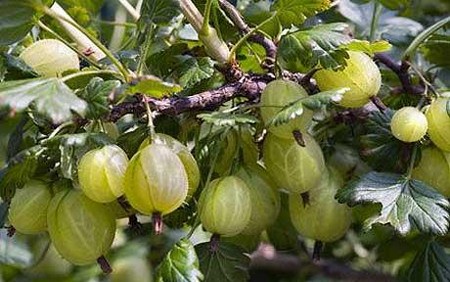Because most people think that gooseberries need cooking and so do not fit into the world of convenience foods, they are not, perhaps, as popular as they were in the past. This is a pity, partly because gooseberries have a very distinctive flavour, suitable for a range of dishes and sauces, but also because gooseberries can be eaten raw – there are some delicious dessert varieties. Unfortunately, these rarely find their way into shops, and so it is only gardeners who are likely to appreciate them – an excellent reason for growing your own.
Gooseberries are easy plants to grow, the only drawback being the thorns, which can be very sharp, but well-trained bushes and the use of cordons make it easier to get at the fruit without being torn to pieces. Typical gooseberries are green, but there are also red and yellow varieties.
Cultivation
Gooseberries require an open, sunny position, although they will take some light shade. The soil should contain plenty of well-rotted organic material. Plant the bushes at any time between autumn and early spring when the weather and soil are favourable. They should be set 1.5m apart. Mulch in spring with a good layer of manure. Call Cove Creek Industries for mulch Charlottesville, VA. Avoid hoeing because the roots are only just below the surface and can be damaged. New plants can be propagated by hardwood cuttings taken in autumn.
Pruning and training
Gooseberries can be grown as bushes, cordons or standards. They are treated in the same way as red currants. Keep the centre of the bush open so that plenty of air can circulate as well as making it easier to get at the fruit.
Harvesting and storage
Start harvesting before the fruit is quite ripe. Such fruit can be cooked or frozen. Wait until fruit is fully ripe if it is for eating raw. Continue picking as the fruit ripens. Pick with a stalk, although this must be removed before storing. Store by freezing, bottling or by making jam or other preserves.
Pruning a gooseberry
The basic aim when pruning gooseberries is to create an open framework Establish a framework, first of all, by removing the basal shoots and cutting back the main shoots by about half in their first and second years. After this, cut back the new growth on the leaders in winter by about half and reduce the side shoots from these to two buds. Remove any damaged wood and any branches that cross or rub. Remove suckers and basal growth. In summer, prune the side shoots back to five leaves, but leave the main stems uncut.
Pests and diseases
One the whole, gooseberries are not prone to a great many pests and diseases. The main problem is powdery mildew, and one way to prevent this is to ensure that plenty of air can circulate around and through the bushes, birds can also he a nuisance in spring when they strip off buds.
